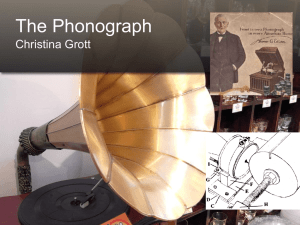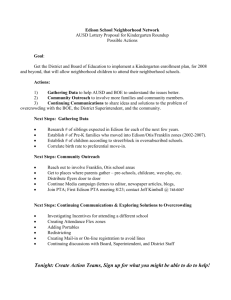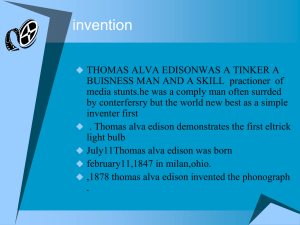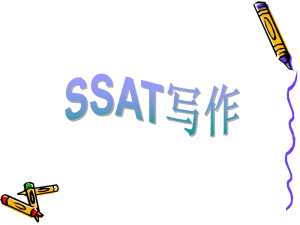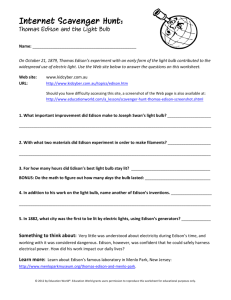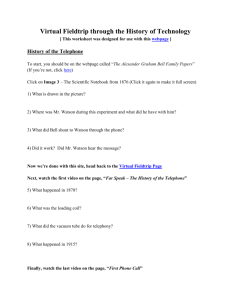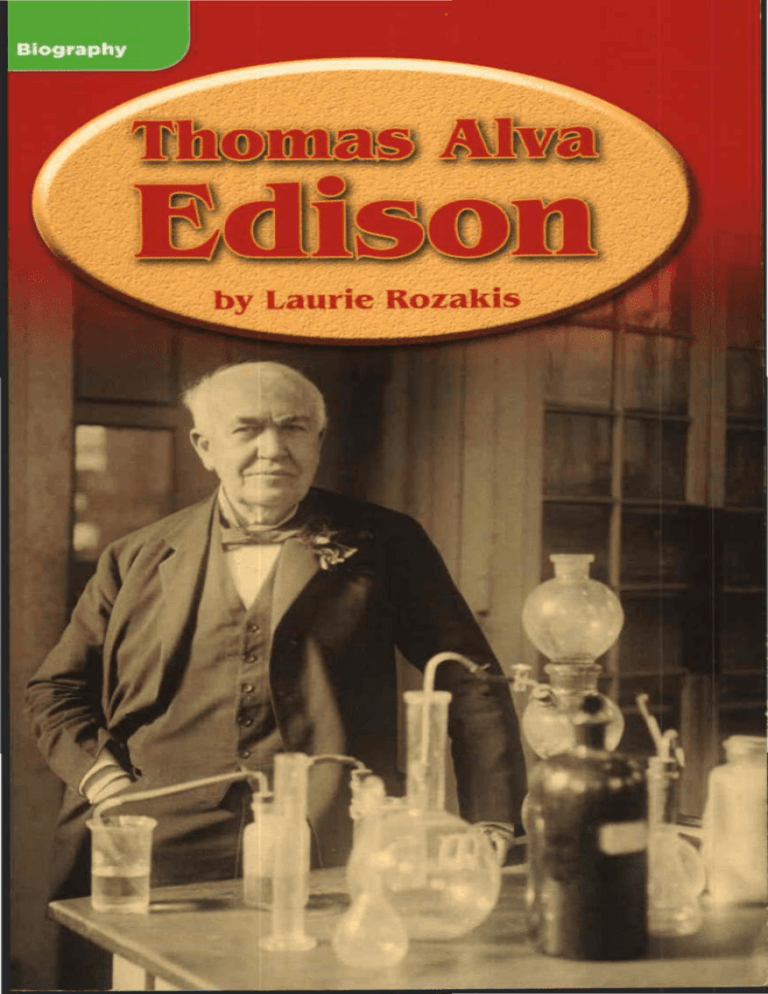
Read to
Fi:ndOut
Read about the
man who brought
STRATEGIES & SKILLS AT A G LANCE
Comprehension
•
Strategy: Generate Questions
•
Skill: Identify Problem and Solution
Vocabulary
•
hilarious, independence, mischief,
us more than
1,000 inventions­
Thomas Alva
(come in) handy, convinced, dizzy,
nowadays, whirlwind
Vocabulary Strategy
•
Dictionary: Idioms
Edison.
CONTENT-AREA VOCABULARY
Words related to inventions
(see glossary)
photo credits
Cover: Bettmann/CORBIS;
1:
Schenectady
Museum/Hall of Electrical History Foundation/
2: (I) Bettmann/CORBIS; (r) CORBIS;
4:
Bettmonn/CORBIS; 5: Bettmann/CORBIS; 6:
Ryan McVay/Getty Images; 7: Bettmann/
CORBIS;
3: FPG/Hulton Archive/Getty Images;
CORBIS; B: Hulton-Deutsch Collection/CORBIS;
II:
(I)
NATIONAL CONTENT STANDARDS
Science
•
Science as Inquiry
•
History and Nature of Science
Schenectady Museum/Hall of Electrical
History Foundation/CORBIS; (r) Royalty­
Free/CORBIS;
12:
15:
13: Ryan
14: Bettmann/CORBIS;
SuperStock, Inc.;
McVay/Getty Images;
Schenectady Museum/Hall of Electrical
History Foundation/CORBIS; 17: John Springer
Collection/CORBIS; IB: Royalty-Free/CORBIS.
Word count: 1,416**
illustration: 9, 10: John Hovel I.
B
Tile McGraw·H/11 Compomes
B Macmillan
• McGraw-Hill
Published by Macmillan/McGraw-Hill, of McGraw-Hill Education, a division of
The McGraw-Hill Companies, Inc., Two Penn Plaza, New York, New York 10121.
Copyright© b y Macmillan/McGraw-Hill. All rights reserved. No part of this publication
may be repro duced or distributed in any form or by any means, or stored in a database or
retrieval system, without the prior written consent of The McGraw-Hill Companies, Inc.,
including, but not limited to, network storage or transmission, or broadcast for distance
learning.
Printed in the United States of America
2 3 4 5 6 7 8 9 109 10 09 08 07 06
**The total word count is based on words in the running text and headings only.
Numerals and words in captions, labels, diagrams, charts, and sidebars are not included.
Thomas Alva
Edison
by Laurie
Rozakis
Table of Contents
Introduction
.
.
.
.
.
.
.
.
.
.
.
.
.
.
.
.
.
.
.
.
.
.
.
.
.
Chapter 1 An Inventor from the Start
Chapter 2 A Bright Idea
.
.
.
.
.
.
.
.
Chapter 3 Let There Be Music! .
Chapter 4 Motion Pictures .
Conclusion
.
.
.
Glossary/Index
.
.
.
.
.
.
.
.
.
.
.
.
.
.
.
.
.
.
.
.
.
.
.
.
.
.
.
.
.
.
..
.
.
.
.
.
.
.
.
.
.
.
.
.
.
.
.
.
.
.
.
.
.
.
.
.
.
.
.
.
.
.
.
.
.
.
.
.
.
.
.
.
.
.
.
.
.
.
.
.
.
.
.
.
.
.
.
.
.
.
.
.
2
.
.4
. 8
.
. 12
.
.
.
.
.
.
.
.
.
14
18
19
Comprehension Check . . . . . . . . . . . . . . . . . . . . 20
steamboat
Louisiana Purchase
War of1812
Introduction
What would the world be like without light
bulbs? We have Thomas Edison to thank for that
bright idea! He also invented the phonograph
and motion pictures.
Thomas Edison is the most famous American
inventor. He came up with more than 1,000
new devices. He worked with electricity and
technology to make our daily lives better.
Find out how this
one man changed
history through his
inventions.
Edison's �
phonograph
steam locomotive
Battle of the Alamo in Texas
The Television
Television was the result of
many inventions by different
people. In 1895 Guglielmo
Marconi invented the first
radio. In 1901 he found
a way to make electrical
signals stronger. In 1923
Vladimir Zworykin invented
0 Look at this
picture. Then
look at a modern
television set.
the first TV camera. Then,
Would you ever
in 1929, Zworykin invented
guess that the
the TV picture tube.
two machines are
related?
The 1800s have been called "The Age of
Invention." That is because many things were
invented at that time. It seemed like a whirlwind
of inventions!
The first steamboat, steam-engine train, and
airplane were invented during this time. The
telephone was invented too. These inventions
changed the way people lived and worked.
1839
Inventions
World Events
1851
sewing machine
1849
bicycle
Chapter
California Gold Rush
1
An Inventor
from the Start
Thomas Alva Edison was born
in 1847 in Milan, Ohio. His
friends called him "Al." His
mother probably called him
"Trouble." That's because he
made mischief. Here is an
example.
Al asked why geese sat
on eggs. His mother said,
"The goose wants to keep
0 The young inventor
her eggs warm. Then they
will hatch."
Al went out. His family looked all over for
him. A few hours later, they found him sitting
on some goose eggs! The eggs had all broken,
though. Al learned that geese can hatch eggs but
people can't.
Al didn't give up on his experiments. When
he was seven years old, his family moved to Port
Huron, Michigan. Al had a hard time in school.
He was smart, but he could not hear well.
-
4
1861
1861-1865
1865
American Civil War
President Lincoln assassinated
elevator
After three months, his mother took him out
of school. She had been a schoolteacher. She
taught him at home. ((My mother taught me how
to read good books quickly and correctly," Al
later said. ((I have always been very thankful for
this early training."
Al built a
laboratory in his
bedroom. His
mother made him
move it to the
basement. The
chemical smells
made her dizzy.
The laboratory :>
Edison worked in
as an adult was
probably very
different than
the one he set
up in his family's
basement.
"If we did all the
things we are really
capable of doing, we
would literally astound
ourselves."
-Thomas Alva Edison
1868
traffic lights
1867
Inventions
World Events
typewriter
United States buys Alaska from Russia
Back then, kids had
a lot more independence
than they do nowadays.
Many kids got jobs early.
Edison worked on the
0 Telegraph machines
use electricity to
railroad when he was
send messages from
just 12 years old. He sold
place to place.
newspapers and snacks.
But he had a problem.
How could he keep doing experiments if he was
working? He solved the problem by setting up a
new lab in an empty railroad car.
Edison learned how to work a telegraph
machine. People used the telegraph to send
messages over long distances. Edison was so
interested in the telegraph that he quit his
railroad job to learn how to use it. He was only
16 years old.
Edison worked at
night. He invented
a way to send
telegraph signals
automatically. It was
his first invention.
6
"I never quit until I get
what I'm after."
-Thomas Alva Edison
1874
1876
telephone, automobile engine
the first zoo opens in the United States
In 1868 Edison moved to Boston. He got a
job with the Western Union Telegraph Company.
At night Edison did his experiments in an
electrical shop.
Edison moved to New York City. One day
one of the Western Union machines broke.
Edison was asked to help. He fixed the machine
with a new part he invented. Western Union
wanted to buy the part Edison had invented.
Edison wanted $5,000 for his invention. But he
was too shy to ask for that much money, so he
did not say anything. Western Union gave him
$40,000! That was a lot of money then. It is still
a lot of money today. Edison knew the money
would come in handy.
<:In 1869 Edison
invented a
machine to show
stock prices.
--
7
1876
1880
toilet paper
Inventions
World Events
Mark Twain's
The Adventures of Tom Sawyer published
Chapter 2
A Bright Idea
Edison used the money to
set up his own laboratory in
Newark, New Jersey. He was
most interested in electricity.
Edison also got married. He
had met his wife at his lab,
of course!
In 1876 Edison set up
a new lab in Menlo Park,
New Jersey. He hired other
inventors to help him.
0 Gaslights were
dangerous.
In the 1800s, people used
gas, oil, and candles to light their homes. Some
of these light and heat sources were not safe.
As a result, there were many fires. Edison was
convinced that there was a safer, better way to
make heat and light.
"I find out what the world needs,
then I proceed to invent."
-Thomas Alva Edison
--
8
1886
1895
radio
Statue of Liberty opens
Other scientists had worked with electricity.
They had proved that electricity could flow from
object to object. They learned that some materials
work better with electricity than other materials.
Edison learned from their work.
In the 1870s some outdoor areas had a form
of electric lighting. They were all linked together.
The electrical current flowed in only one way.
That meant that if one light bulb went out, they
all went out.
First, Edison had to find a way to keep the
lights on if one bulb went out. Second, he had to
find a good material for the thin wire inside the
light bulb. Third, he had to make the light bulbs.
0 Wiring light bulbs with the current flowing in only
one direction means that if one light bulb blows
out, they all blow out.
--
9
1898-1899
Inventions
World Events
1901
1902
vacuum cleaner
air conditione
Spanish-American War
Edison's first problem was keeping the lights
on if one light bulb went out. He solved this
problem by using parallel circuits.
Edison's second problem was finding a good
material for the wire. Edison tried metal, wood,
and cotton. He even tried hair from a coconut
shell! Lewis Latimer, a scientist working with
Edison, solved this problem by using carbon.
Edison's third problem was making the light
bulbs. Edison solved this problem by setting up a
glass-blowing factory to make the bulbs.
In 1879 Edison made the first light bulb that
lasted a long time. Edison's bulb burned for
about 13 hours. By December 1878, Edison had
lit up his lab and home with light bulbs.
::: Edison used
parallel
circuits
to keep
electricity
flowing if
one bulb
went out.
10
lane, crayons
................. Canal opens, connecting the Atlantic and Pacific Oceans
Edison's light bulb and
a modern light bulb.
How are they the
same? How are they
different?
How could Edison bring this electric power
to many people? He started by building a big
electric generator.
Then Edison built an electric power station in
New York City. He called it the Edison Electric
Illuminating Company. On September 4, 1882, a
worker pulled a switch. Suddenly 85 people had
electric power in their homes! Soon everyone
wanted electric power. Edison made electric
lighting possible for homes, offices, and streets.
"I have accomplished all that I promised," Edison
told reporters.
--
11
Inventions
1908
1910
automobile assembly line
motion pictures
World Events
Chapter 3
Let There Be Music!
In 1877 Edison invented a talking doll for his
daughter. She thought this toy was hilarious. It
gave Edison an idea. Why not make a machine
that could record and play voices and music?
Edison had already invented a way of recording
telegraph clicks. To record people's ·voices, he
covered a metal cylinder with tinfoil. He used
a needle to make marks on the tinfoil. To work
the machine, he turned the cylinder. The needle
"played" back the sounds made on the tinfoil.
0 Edison and his phonog raph.
1912
The
Titanic sinks on its first trip across the Atlantic
In 1877 Edison tested his machine. He spoke
into the microphone. Edison played it back.
The machine said his words exactly. Edison had
invented the phonograph!
The phonograph was a big hit. Edison hired
people to show how the phonograph worked. All
over the country, people paid 25 cents to hear it.
Some people paid $30 to buy a phonograph. That
was a lot of money back then.
From Phonographs to MP3 Players
After Edison's phonograph, Leon Berliner invented
a machine called the gramophone. It worked like
Edison's machine but used a round disc instead
of a cylinder. In the United States, gramophones
were also called record players. Record players
play vinyl discs. Around 1980
people invented CD players. CD
players play compact discs, or COs.
Then MP3 players were invented.
An MP3 player doesn't play a disc
at all. Instead music is stored on a
computer file.
13
1913
zipper ,
Inventions
World Events
Chapter 4
Motion Pictures
After Edison invented the phonograph, people
gave him a new name. They called him "The
Wizard of Menlo Park." Edison was about to
invent another great thing-motion pictures! This
invention would change the world just as electric
light and the phonograph had.
"I am experim enting
upon an instrument
which does for the eye
what the phonograph
does for the ear, which
is the recording and
reproduction of things
in m otion."
-Thomas Alva Edison
Sunnyside, an early �
motion p icture, was
released in 1919.
14
Russian Revolution
0 This painting shows Edison (center) and some
of his workers testing a new lamp in his Menlo
Park laboratory.
Edison wanted to photograph people and things
in motion. George Eastman had invented a new
ty pe of camera film. In 1889 Edison got some of
this film. He cut it into long, thin strips. One of
Edison's helpers, William Dickson, ran the film
through the camera. The camera took pictures of
things and people as they moved.
15
1927
Inventions
World Events
Charles Lindbergh flies solo across Atlantic
Edison had done it again. This time he
had invented a motion picture camera that
recorded action on film. He called his machine a
kinetograph.
Now Edison had another idea. How could he
play the moving pictures back? He invented a
motion picture player. He called it a kinetoscope.
He watched his recordings on his new invention.
These two inventions led to the invention of the
movie camera and movie projector.
Patents
Inventions are protected by patents. A patent is
an official document issued by a government. A
patent gives a person or company the right to
be the only one to make or sell an invention for
a certain number of years. Edison had more than
1,000 patents. Here are the main steps in writing
a patent application in the United States.
Step#l
+step#2
+
Name the
Tell what problem
Describe the
invention.
the invention solves.
invention.
Step#4
Draw pictures and take
16
+step#3
photos of the invention.
#5
+ Step
Explain why the invention
needs a patent.
1928
1929
bubble gum
The Great Depression begins
The Sneeze
The Sneeze is one of the first movies ever made.
The star was John Ott. He was a scientist who
worked with Edison. Edison recorded the movie's
sound on the phonograph.
0 Photo sequence from The Sneeze.
Edison built a movie studio in New Jersey. He
made films of boxers, dancers, and the circus.
The Great Train Robbery was his first movie that
told a story.
Edison made more than 2,000 movies. He
even made color movies. An artist painted each
piece of film.
17
Conclusion
Thomas Edison brought electric light to the
world. He invented the phonograph and motion
pictures. But Edison never stopped inventing. "He
invents all the time, even in his dreams," his
wife said.
Thomas Alva Edison died on October 21,
1931. When they heard the news, people all
over the United States turned off their lights for
one minute. They did this to honor the great
inventor.
"The thing I lose
patience with the m ost
is the clock. Its hands
m ove too fast."
-Thomas Alva Edison
Electric lights are beautiful :)
as well as useful. Some
people think the Eiffel Tower
looks best at night-when it
is all lit up.
Glossary
electricity (i-lek-TRI-suh-tee) energy that is in the
form of a current. Electricity is the power that
lights lamps, heats some houses, and makes
appliances work. (page 2)
generator (JE-nuh-ray-tuhr) a machine that makes
electric power (page 77)
laboratory (LA-bruh-tawr-ee) a room or building
where scientists carry out their work (page 5)
motion picture (MOH-shuhn PIK-chuhr) a movie;
a series of pictures projected so quickly that it
seems like the objects in the pictures are moving
(page 2)
phonograph (FOH-nuh-graf) a machine for playing
records (page 2)
technology (tek-NOL-uhj-ee) scientific knowledge
that is applied for practical purposes (page 2)
Index
"The Age of Invention," 3
light bulb, 9-77, 78
motion pictures, 2, 74-77, 78
phonograph, 2, 72-74, 78
telegraph, 6-7, 72
19
Comprehension Check
Summarize
Proble-m
Use a Problem and Solution
Chart to tell what problems
Thomas Edison identified and
how he solved them. Then use
+
the information on the chart to
summarize the book.
Solution
Think and Compare
1. Look back at page 6. What problem did Edison
see? How did he solve it? (Identify Problem and
Solution)
2. Edison was convinced he could accomplish
anything he set out to do. Do you agree with
this opinion? Why or why not? (Evaluate)
3. You know that the phonograph is used to play
music. What other uses does this technology
have today? (Apply)
20
Solve
a
Problem
Edison often invented things to solve
problems that he saw. Think about a
problem that you solved. Write a paragraph
telling about the problem. Be sure your
topic sentence identifies the problem.
The other sentences should tell how you
solved it.
Describe Your Invention
Think of an invention of your own. Describe it.
Use a flowchart to show how your invention
D----7D----7D----7D
'1'1701
'I
7110021 '1 3 0b47

